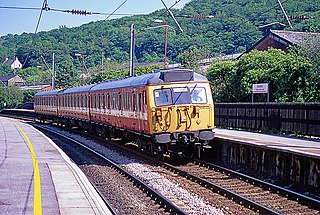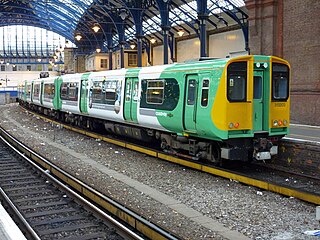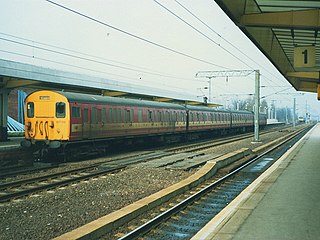
The British RailClass 411 (4CEP) electric multiple units were built at Eastleigh works from 1956–63 for the newly electrified main lines in Kent. These units, which used a British Railways Mark 1 bodyshell, were based on the earlier Southern Railway 4 COR design, built in 1937. Variants of the class 411 design included the class 410 and class 412 4 BEP units, which contained a buffet car in place of a standard trailer. They were later used on services in Sussex and Hampshire; following the privatisation of British Rail in 1995, the units were used by the Connex South Central, Connex South Eastern and South West Trains franchises. They were replaced by Juniper, Desiro, and Electrostar units. The fleet's lifespan was 49 years. These units are the longest-lived BR Mark 1 EMUs.

The Southern Railway (SR) gave the designations 4-COR, 4-RES, 4-BUF and 4-GRI to the different types of electric multiple unit built to work the route between London Waterloo and Portsmouth Harbour. The 4-COR type units survived long enough in British Rail ownership to be allocated TOPS Class 404. The COR designation had previously been used for the 6-PUL units and was reused by them during World War II when the Pullman car was stored, but this stock was different from the 4-COR units.

The British Rail Class 308 alternating current (AC) electric multiple units (EMU) were built by British Railways' Holgate Road carriage works in three batches between 1959 and 1961. They were initially classified as AM8 units before the introduction of TOPS.

The British Rail Class 487 electric multiple units were built by English Electric in 1940, for use on the Waterloo & City line.

The PEP Stock were prototype electric multiple units used on British Rail's Southern and Scottish Regions during the 1970s and early 1980s. They were forerunners of the British Rail Second Generation electric multiple unit fleet. Three units were built, one two-car unit (2001), and two four-car units (4001/4002). Under TOPS, the driving cars were originally classified as Class 461 with the non-driving motor cars as Class 462. They were later reclassified as Class 445 (4PEP) and Class 446 (2PEP).

The British Rail TC multiple units were unpowered fixed formations of 3 or 4 carriages with a driving position at each end of the set, converted by BR's Holgate Road carriage works from locomotive-hauled Mark 1 carriages in 1966–1967 and 1974. The units built on experience gained from the prototype 6TC unit. In time the 3 car units were reformed into four car units to match the rest of the fleet and later classified as Class 442. This was later changed to Class 491, under which they spent the majority of their working lives. Shortly before withdrawal they were reclassified Class 438 and the units were renumbered to 8001-8034.
The Southern Railway (SR) gave the designations 6 PUL, 6 CITY and 6 PAN to electric multiple units built to work the routes between London and Brighton, West Worthing and Eastbourne. None of these units survived long enough in British Rail ownership to be allocated a TOPS class number. The 6 PUL units were designated 6 COR until 1935.

The British Rail Class 313 is a dual-voltage electric multiple unit (EMU) train built by British Rail Engineering Limited's Holgate Road carriage works between February 1976 and April 1977. They were the first production units that were derived from British Rail's 1971 prototype suburban EMU design which, as the BREL 1972 family, eventually encompassed 755 vehicles over five production classes. They were the first second-generation EMUs to be constructed for British Rail and the first British Rail units with both a pantograph for 25 kV 50 Hz AC overhead lines and contact shoe equipment for 750 V DC third rail supply. They were, additionally, the first units in Britain to employ multi-function automatic Tightlock couplers, which include electrical and pneumatic connections allowing the coupling and uncoupling of units to be performed unassisted by the driver whilst in the cab.

The British Rail Class 307 electric multiple units were built by BR at Eastleigh Works from 1954 to 1956. They were initially classified as AM7 before the introduction of TOPS.

The British RailClass 303 electric multiple units, also known as "Blue Train" units, were introduced in 1960 for the electrification of the North Clyde and the Cathcart Circle lines in Strathclyde. They were initially classified as AM3 units before the introduction of the TOPS classification system, and were the dominant EMU on the Glasgow suburban railway network for over 25 years before being progressively phased out by newer rolling stock. The final units were withdrawn from service in 2002. The fleet's lifespan was 42 years.

The British Rail Class 455 is an electric multiple unit passenger train built by BREL between 1982 and 1985. It is operated on suburban services in Greater London and Surrey by South Western Railway, as well as formerly by Southern.

The British Rail Class 310 was a slam-door, alternating current (AC) electric multiple unit (EMU) introduced in 1965 as part of the West Coast Main Line electrification project. They were initially classified as Class AM10 units before the introduction of the TOPS classification system. Constructed at BR's Derby Carriage and Wagon Works. They consisted of four carriages - a second class driving trailer, a second class trailer, a second class motor car and a composite driving trailer. The maximum speed was 75 miles per hour (121 km/h). A glass partition behind the driver's cab enabled passengers in the leading and rear coaches to view the line ahead or behind.

The British Rail Class 504 was a unique type of electric multiple unit that ran on 1,200 V DC third rail with side-contact current collection. All other mainline UK third rails have the electric "shoe" on top of the rail. The type was used only on the Bury Line between Manchester and Bury. They were built in 1959 at Wolverton Works, and the body was a standard type used for several electrification schemes of the time, but the high DC voltage through a side-contact third rail was unique in Britain. The trains replaced the previous five-car units built by the Lancashire and Yorkshire Railway (LYR) for the route, which had inaugurated this electrification scheme in 1916.

The British Rail Class 432 (4-REP) electric multiple unit passenger trains were built by BR at York Works from 1966 to 1967 and in 1974. The units were built to power the TC trailer units on services on the South West Main Line. Fifteen four-car units were eventually built. The motor coaches were new build, but the trailers were converted from Mk1 hauled stock. They were initially classified as Class 441 and numbered 3001–3015. This was later changed to Class 430, under which they spent the majority of their working lives. Shortly before withdrawal they were reclassified Class 432 and the units were renumbered as 2001–2015. The fleet had a lifespan of 26 years.

An electric multiple unit (EMU) is an electric train capable of operating in multiple with other EMUs that does not have a separate locomotive, typically passenger trains with accommodation in every vehicle and a driving position at each end. The term can also be used to describe a train such as the Advanced Passenger Train that was a permanent formation with a non-driving power car. As of December 2010 two-thirds of the passenger carriages in Britain are formed in EMUs.

The British Rail Class 501 electric multiple units were built in 1955/56 for use on the former LNWR/LMS suburban electric network of the London Midland Region. A total of 57 three-car units were built.

The British Rail Class 210 was a type of diesel-electric multiple unit (DEMU) passenger train designed and constructed by British Rail Engineering Limited's Derby Litchurch Lane Works.

The Networker is a family of passenger trains which operate on the UK railway system. They were built in the late 1980s and early 1990s by British Rail Engineering Limited and Metro Cammell. The trains were built for the Network SouthEast (NSE) sector of British Rail, which is where their name comes from. They are all multiple-unit trains.

Network SouthEast (NSE), the sector of British Rail which ran passenger services in London and southeast England between 1986 and 1994, operated a wide variety of rolling stock during its existence. The majority of the network was electrified, and further electrification schemes took place during the 1986–1994 period; and the 7,000 vehicles owned by NSE in 1986 consisted of a mixture of electric, diesel-electric and diesel multiple units, diesel locomotives and the coaches they hauled.


















